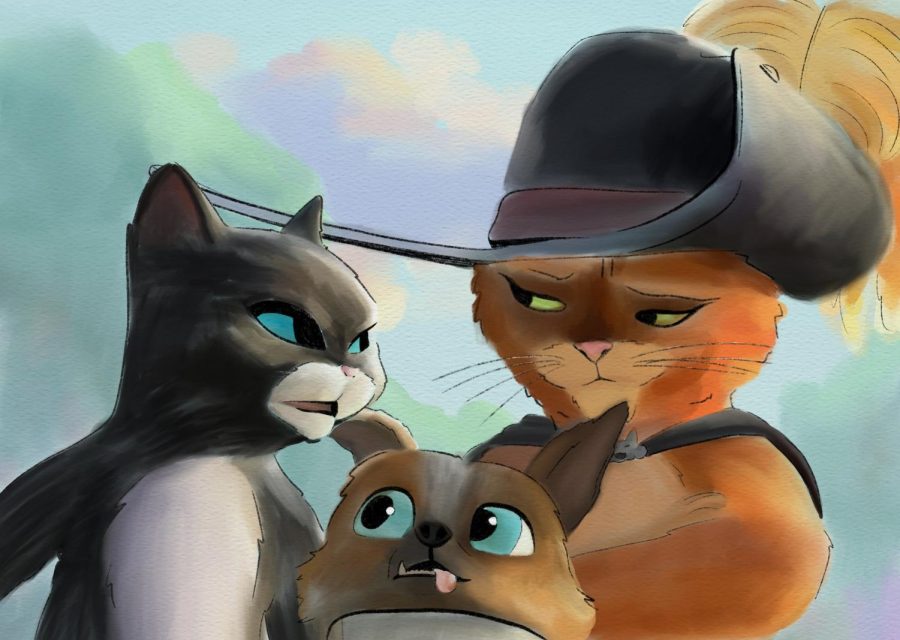“Puss in Boots, The Last Wish” is the purrfect movie you’ve been wishing for
FAVORITE FEARLESS TRIO: Puss, Kitty and Perrito share affectionate banter as they travel through the dark forest.
February 27, 2023
Many people may not expect themselves to be moved by a talking cat, but after watching the newest movie from Dreamworks, they just might think otherwise. With visual spectaculars and thorough crafting of each character, “Puss in Boots, The Last Wish” defies the audiences’ expectations in astounding ways.
Directed by Joe Crawford and co-directed by Januel Mercado, the sequel to the 2011 “Puss in Boots” follows Puss (Antonio Banderas), a ginger gato who has—or at least used to have—nine lives. After making a series of irrational decisions, Puss realizes that he is down to his last life. When he learns of a star that can grant any wish, Puss sets out on a journey to look for the Wishing Star and reclaim what he had wasted away. With his adorable sidekick Perrito (Harvey Guillen) and feisty Kitty Softpaws (Salma Hayek), Puss ventures into the dark forest to redeem his legacy as everyone’s “favorite fearless hero.”
As the fearless feline searches for the star, the animators turn Puss and his world into a work of art by breaking the boundaries of animated movies. Instead of the cookie-cutter style of 3D animation (think of Minions and Shrek—after watching similar styles for over a decade, it can get pretty old), the animators splashed their creativity into a satisfying streak of style that was inspired by “Spider-Man: Into the Spider-Verse” and the 1988 anime film “Akira.” Thanks to visual tweaks such as comic book panels and smearing animations, the movie turns into a fiesta for the eyes within the first few minutes of the film.
While the audience visually feasts on the action-packed scenes, Puss’ energetic theme song strums in the background as he parties through the night, drawing the audience into a thrilling experience while the tune casually strides into the depths of their minds. The cheerful melody isn’t the only tune that gets etched into the minds of viewers, however. An eerie whistle follows a wolf who is after Puss, providing a chilling effect for the crowd. Whenever the lazy whistle draws out the sinister song in any part of the movie, the audience, along with poor Puss, can instinctively infer that the red-eyed wolf is close by, making the villain quite memorable.
Another memorable part of the film is Puss’ sidekick, Perrito, the lovable dog who steals the audience’s hearts. Though he may seem like a naive character at first glance, Perrito defies the trope of a static sidekick. From a disturbingly tragic backstory to incorporating several bleeped-out words, viewers chuckle at the surprising touches of dark humor from a seemingly innocent character.
Some are reluctant to watch the movie because of the dark implications within the film, along with concerns about whether the film is appropriate for a younger audience. Fortunately, the movie effectively balances the appeal for kids and adults alike through humor and genuine messaging. For instance, despite Perrito’s dark past and language, his optimistic attitude toward appreciating life serves as an important reminder for both young and mature audiences to embrace each coming day.
With sparks of creativity and a wonderful appeal to both the eyes and mind, “Puss in Boots: The Last Wish” boldly takes on an original color while appealing to a wide range of audiences, serving as the perfect wake-up call for other film industries to broaden their horizons. Sprinkled with colorful life lessons and the perfect dose of darkness, the movie ultimately raises the standards for what a purrfect movie should be.



![AAAAAND ANOTHER THING: [CENSORED] [REDACTED] [BABY SCREAMING] [SIRENS] [SILENCE].](https://thehowleronline.org/wp-content/uploads/2025/06/lucy-1200x800.jpg)





















































![AAAAAND ANOTHER THING: [CENSORED] [REDACTED] [BABY SCREAMING] [SIRENS] [SILENCE].](https://thehowleronline.org/wp-content/uploads/2025/06/lucy-300x200.jpg)
Daniel
Mar 9, 2023 at 12:10 pm
Appreciated for this exciting review with great discernment, I would need to see the movie again with somewhat different perspective which could evoke the depth of film.